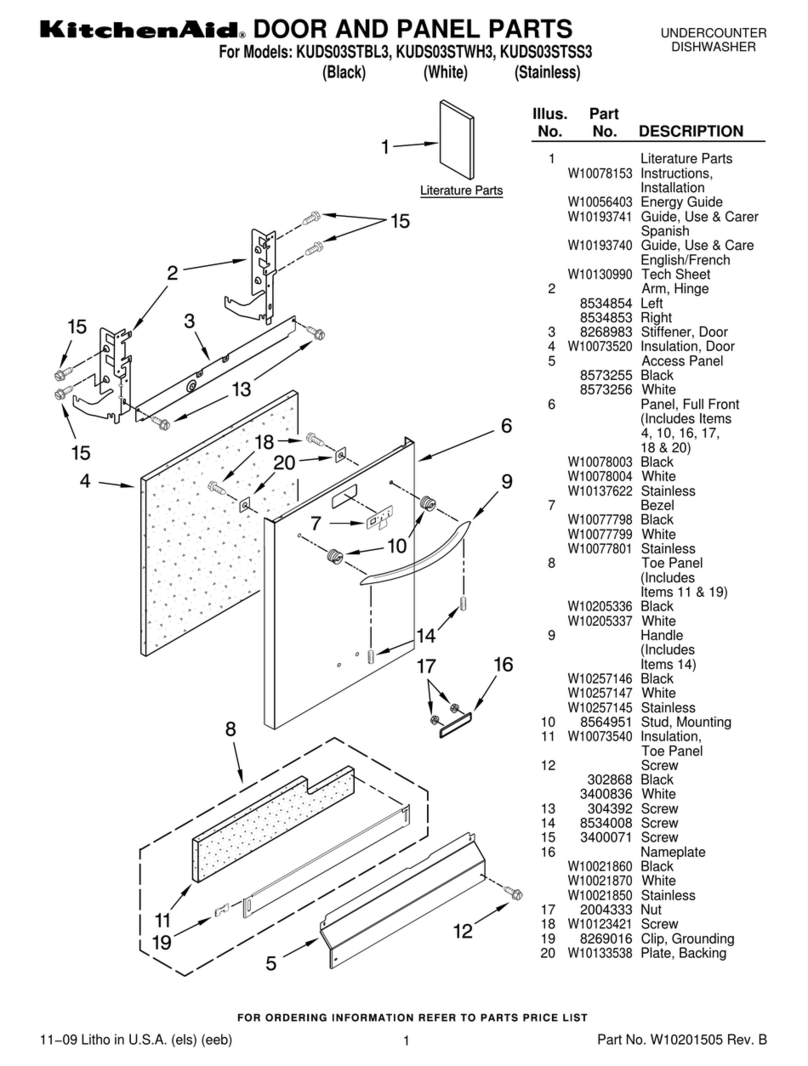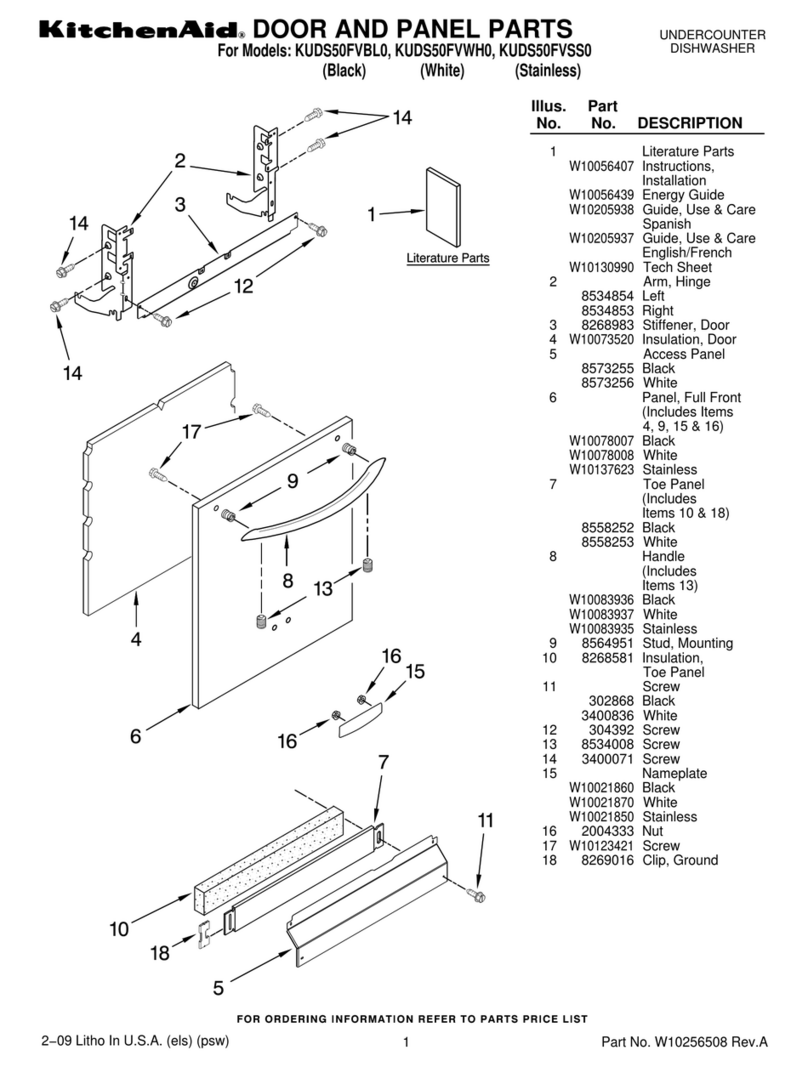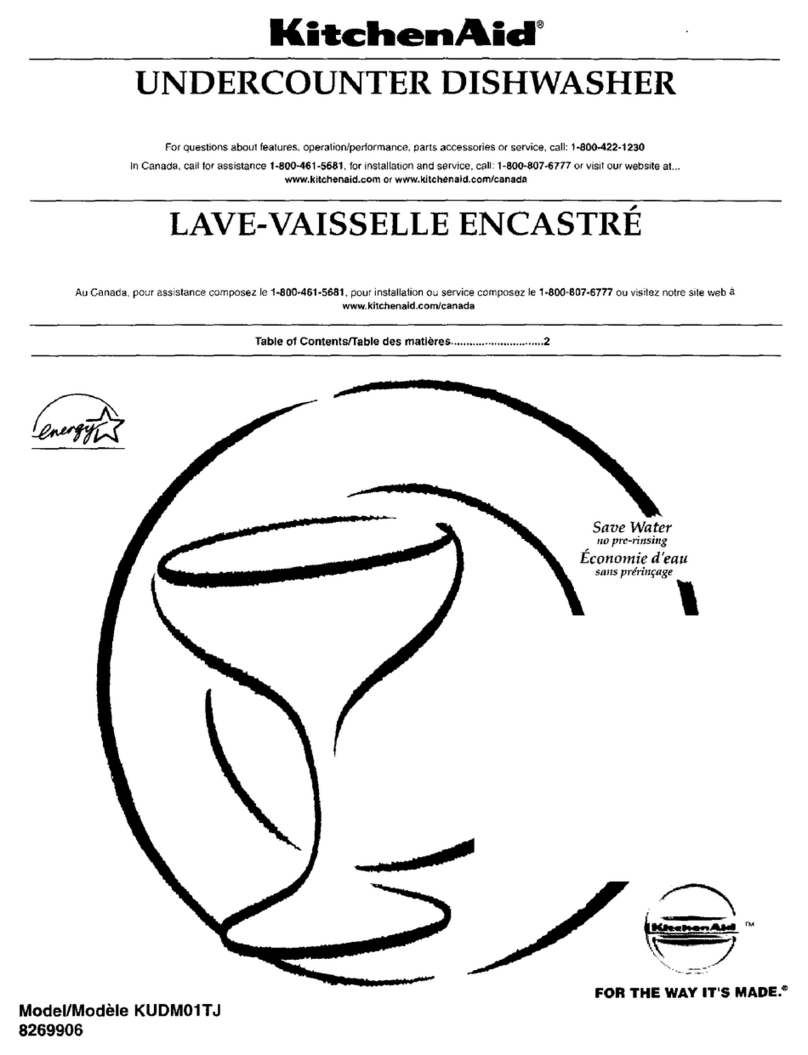Safety Instructions
2
[_ KITCHENAID DISHWASHERS OP-
ERATE ON 115 VOLTS, 60 HERIZ
A.C. house current. They cannot be
converted to operate on 220 vohs, 50 hertz house
currc-n_.
FC)R SAFE FY'S SAKE . . . remove the door hinges
or [at(h mechanism if your dishwasher is dis-
(arded, or otherwise not in use. In California it is
a misdemeanor for anyone discarding the appli-
ance not to follow this safety procedure which
can save the lives of curious children at play.
A possibility exists that HYDROGEN GAS MAY
FORM IN AN UNUSED HOUSEHOLD WATER
HEATING SYSTEM (generally requires two weeks
or more). To prevent the remote possibility of in-
jury, we suggest opening the hot water faucet at
the sink before starting the dishwasher. I( hydro-
sen is present, there will probably be a sound
such as air escaping as the water begins to flow.
Avoid smoking or any open {lame near the faucet
while it is open.
IMPORTANT INFORMATION
CAUTION: To protect against possible rupture of fin
valve, BE SURE water lines leading to the dishwasher
as well as water lines in the dishwasher are protected
against freezing. Such ruptures are not covered by
the warranty.
Operating Your Dishwasher
Step 1... Load dishes into racks according to in-
structions on pages 2 through 6.
Step 2... Add detergent to detergent dispenser--
page 7. Check rinse agent dispenser--
pa_e 8.
Step 3... Close and latch door.
Step 4... Push button for desired cycle -see page
9 for description of cycles. The rest is
automatic. The dishwasher will rinse,
wash and dry according to the cycle
selected and then turn itself off.
Loading Your Dishwasher
PREPARING THE LOAD
No hand rinsing is necessary. Scrape leftover food,
bones, toothpicks and other hard items from
dishes, silverware, pans, etc. Note: f)o not pre-
wash dishes with liquid detergent, a< this type de-
tergent wil! (ause sudsing in the dishwasher. Such
sudsing will _low wash arm and cause poor clean-
ingand/orspottingand filming on the dishes.
Certain dried-on foods are more difficult to re-
move if left to dry over a period of time. If dishes
are not going to be washed fairly soon after use,
run a Rinse & tSold Cycle. This cycle rinses most
of the soil from dishes and generally keeps them
moist until the next wash cycle is run.
SPECIAL ITEM tOADING
Fragile or Lightweight Items Load Stemware,
Glasses and Lightweight items by securing in a
stable manner. The upper rack pro\.ides the most
stability for such items.
manner may be subject to color fading. When in
doubt as to,,vheliler your china is dishwasher safe,
first check with the china manufacturer. If the
manufacturer cannot be contacted, a small piece
of china may be test-washed for several weeks to
determine if the pattern will fade. It is the user'_
responsibility to determine if delicate crystal and
china dTould he dishwadTer washed.
China or Crystal A few types of crystal and china
may be damm4ed by the combined action of high
water temperatures, detergents, and wash action
in adishwasher. Check china or crystal manufac-
turer's recommendations he(ause manufacturing
processes do \ ary.
Most f)eco_aled Fine Chim/manutactured h_da\
is color safe rn automalic didwcadler_,. [)e(()ra
tions under lhe glaze,, thcP, protecled by an over
glaze, are usually safe from fading. [)e_m/lUm,
af)plied over ttle glaze and then fired into tt, are
often dishwa_her',afe. Older patterns made in tlni_
Plastics Dishe', molded fr(tm r_lelamine _.om-
pound,, (_,u_h a'_ ,\lelma() may be _-afel} dish-
\_,astler vvash(:'d. ()lher piaqic ulerT_,il< \'ar_ in their
ability to \_ilM, tand high water temperature and
detergent_, u<ed ir3 an automatic di_h\va_,her.
(/}e( k flTal)uf,)( turet'_ le(()l)Tt't)el](l,}ti()/7",



















































